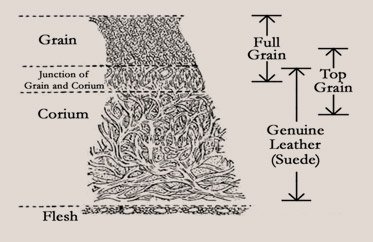When buying a new leather sofa, one of the most important things to consider is the type of leather used for the couch. Some manufacturers will cut corners and either source inferior leathers or use a combination of cheaper materials on the sides or the backs of the couch. So what is the best leather for a sofa?
Full Top Grain leather is the best type of leather for a sofa. However this comes at a price, as sofas made of full top grain leather are the most expensive. It also depends on what sort of living situation you have as different leathers are more appropriate for families with small children. Aside from leather types it is important to be familiar with the types of protectants and dyes used in creating the leather.
We've created this guide to review the different types of leather used for making couches, while also providing information on the additive protectants and dyes. Be sure to also see our guide 'What Is Leather' for more information on the tanning process and the different leathers.
If you have any questions or comments, feel free to get in touch with me at tom@bestleathercouches.com.
Top Grain Leathers
When we mention the word 'grain' this refers to the 'composition and texture of the hide' itself. When we mention 'top grain' leather this refers to the outer most layer of an animals hide, that which is used to make the leathers on our sofas, chairs and other items. For most leathers used on furniture, we are discussing cattle hides; most leather sofas use either a steer hide (better quality) or cow hide (lesser quality).
When leathers are made at a leather tannery one of the first parts of the leather making process involves 'splitting' the animal hide. The split in the hide leads to a 'top grain' leather (the outer most portion of the hide) with the remainder known as the 'splits'. This video shows a tannery splitting the hide:
The top grain of the cow hide has all the grain, all the fibers that are twisted together. This is ultimately the most durable part of the hide and the best leather than can be used for leather sofas.
The 'top grain' of the hide is used to create several different types of leathers. The outer most portion of the top grain that is not altered or sanded down at all is known as 'full grain', or a 'full top-grain" leather. The top grain of the hide that is sanded or buffed out to remove the imperfections of the hide is known as the top grain (yes confusing I know).
A top grain leather is the next level down from the full grain is often referred in the furniture industry as a 'corrected leather' or 'enhanced'. Many of the leather sofas advertised on the big furniture sites are using some form of 'top grain' leather.
Nubuck is another type of top grain leather in which the leather has been sanded on the grain side to give it a velvet, suede like feeling. We do not recommend Nubuck leather for any new sofa purchases as the material wears down easily and very difficult to take care of.

Let's take a closer look at some of the 'Top Grain Leathers':
Full Grain Leather
Sometimes referred to as 'full top grain', this is the cream of the crop as far as leathers are concerned. These leathers carry all the imperfections and natural markings of the animals hide, such as scarring, bites, etc, and the surface and cell structure of the hide has not been altered at all. Of the overall global hide supply, full grain leather accounts for only about 4-5% of total supplies.
Comfort
Durability
cost
stain protection
Top Grain Leather
A top grain leather in which the top of the hide is sanded down to remove the imperfections of the hide. A grain pattern is then imprinted into the hide, with color pigments added, providing a more uniform look. Top grain leather is usually thinner (due to the top grains being removed) and not quite as durable as a full grain.
comfort
durability
cost
stain protection
Split Leather
When hides are split, you get the top grain (the best part of the hide) with the remains known as the 'splits'. Splits are often known in the industry as a 'Genuine Leather', and commonly used in lower grade furniture. Also, there are many times a manufacturer will use top grain leather on the seating areas, while using split leather on the non-traffic areas, such as the sides and back of the sofa.
Bi-cast leather is another type of lower grade, split leather that takes the splits in combination with different types of chemicals and compounds to create a leather like material.
"Genuine" Leather
Genuine leather is another term for furniture materials made from the lesser grade 'splits' from a cow hide. These are less durable leather, is prone to scratching and wears out quite easily. For anyone looking to cut some corners and save some money, it could be okay in some situations to find a leather sofa that is only using genuine leather on the non-touch areas of the sofa.
comfort
durability
cost
stain protection
Bicast Leather
Bicast leather is a type of material (many in the industry don't call it a leather) in which a manufacturer will take the splits from the hide and add a layer of polyurethane to provide some strength to the material. When you are looking a new leather sofas, be sure to check the materials used to watch out for polyurethane. This is really not recommended as a material for any new leather purchase as bicast leather is not durable and will wear down very quickly. Buying a bicast leather sofa is sort of like buying a particle board table or desk. It's not going to last.
comfort
durability
cost
stain protection
Bonded Leather
A step down from bi-cast is bonded leather. These terms are often used interchangeably but there are some differences. Let's discuss.
Bonded Leather
Bottom of the barrel leather material. Bonded leather is made from leftover scraps at the tanneries which are ground up and glued back together to form a material that looks and like leather. They are then finished and embossed with a grain pattern to give it a similar look to real leathers. The problem being that these man made materials are not worthy of any piece of furniture. Avoid at all costs.
comfort
durability
cost
stain protection
Faux Leather
Not real leather, but figured I would add it here since many ask about it. Here's a good video about how they make synthetic leathers:
Faux Leather
Faux or fake leathers are made from PVC and other chemicals (even fake leather smell!) to create materials that look like real leather. They are really awful materials and should never be purchased for any new piece of furniture.
comfort
durability
cost
stain protection
Some Notes on Aniline Dyes, Colors and Protectants
Full or pure aniline is a type of dye process in which a full grain leather is dyed with a transparent dye, keeping all of the natural markings of the hide intact. This type of dyed leather often provides less stain protection. Due to the transparency of they dye, all of the markings of the hide are visible and intact. Some times wax coatings are added to help with water staining.
Semi-aniline is usually found with top grain leathers in which a dye is added, along with a protective top coat color which helps provide more stain protection for a leather. Semi-aniline dyed leathers tend to have a bit of a less suppler feel than a pure aniline. These leathers are great for families with small children.
Protected or Pigmented - When a top grain leather is sanded down to remove imperfections, the tannery will emboss a new grain pattern onto the leather. Afterwards, a color or pigment is added along with a protective seal. This is essentially the additional step added to the semi-aniline process which provides the protection from staining versus a full aniline leather.

